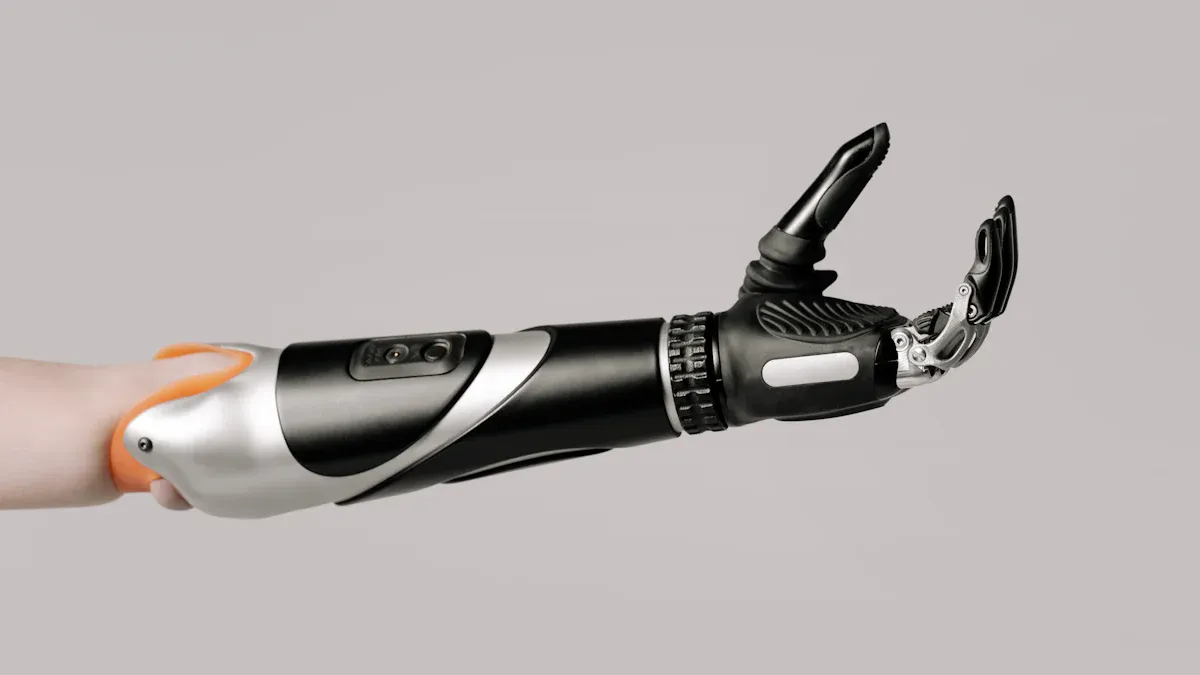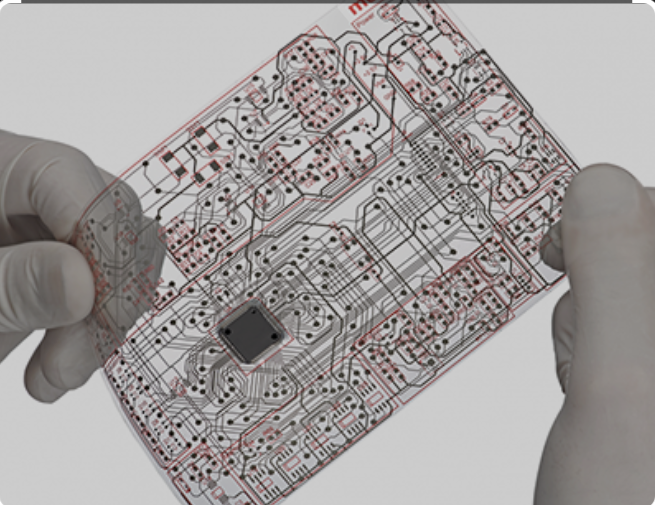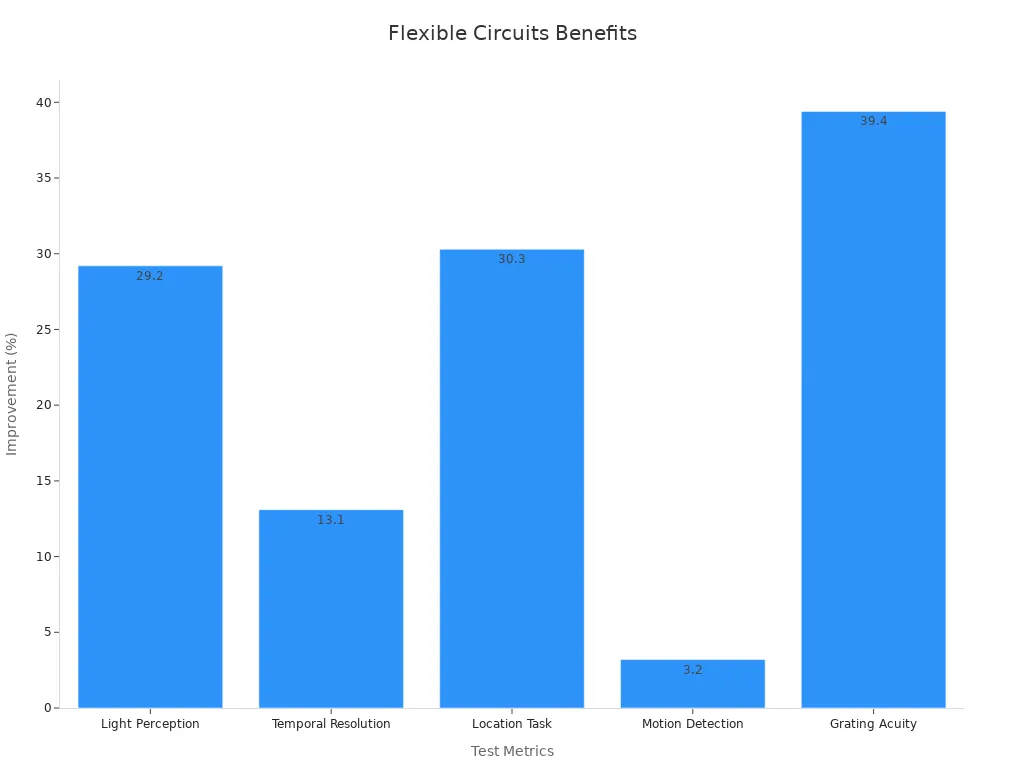How Flexible Circuits Are Revolutionizing BrainPort Technology
Think about a tool that lets you “see” using your tongue. It can also help people get back lost senses. BrainPort technology makes this happen by turning sensory data into signals. These signals are understood by your brain. Flexible circuits are very important for this invention. They can bend and fit the shape of your body. This helps them work better with your body’s systems. Their flexibility improves how well they work and feel. This makes the technology easier to use. By swapping stiff parts for flexible ones, these circuits change how BrainPort gives sensory feedback. This makes the experience smoother and easier to understand.
Key Takeaways
- Flexible circuits make BrainPort more comfortable to wear. Users can use it longer without feeling discomfort.
- These circuits send clearer signals, improving touch feedback. This helps users understand their surroundings better.
- Flexible circuits help BrainPort assist with more conditions. It can help with hearing and balance problems, not just vision loss.
- These circuits let BrainPort combine senses for better learning. This makes the user experience richer and easier to understand.
- Future flexible electronics may make BrainPort work even better. They could change how we treat sensory loss and brain technology.
Understanding BrainPort Technology
Purpose and Functionality of BrainPort
BrainPort helps people with vision loss sense their surroundings. A camera on glasses captures what’s in front of you. This information turns into signals sent to your tongue. The Tongue Display Unit (TDU) is a small device that does this. It has tiny electrodes that gently stimulate your tongue. These signals let you “feel” what the camera sees.
Here’s a simple breakdown of how it works:
| Evidence Description | Details |
|---|---|
| Functionality of BrainPort | Turns visual data into feelings on the tongue. |
| Training Requirement | Needs practice to understand tongue signals as images. |
| Impact on Sensory Feedback | Helps blind users detect objects and move around better. |
This device doesn’t bring back sight but offers a new way to “see.” With practice, you can find objects, identify shapes, and move through spaces.
How Sensory Substitution Works
Sensory substitution replaces one sense with another. BrainPort changes sight into touch. The tongue works well because it has many touch sensors. Bright spots in the camera’s view feel stronger on your tongue. Darker spots feel weaker or not at all. Your brain uses these patterns to “see” through touch.
- The camera sends images to the TDU.
- The TDU sends signals to your tongue.
- Your brain turns these signals into visual-like information.
This shows how amazing your brain is. It can use touch to do what vision usually does.
Challenges in Traditional BrainPort Systems
Old BrainPort systems use stiff parts that feel uncomfortable. These hard materials don’t fit your body well. Using them for a long time can be tough. Also, learning to understand the signals takes a lot of effort. This makes it harder for some people to use.
Flexible circuits solve these problems. They are softer and fit your body better. This makes the device more comfortable and easier to use. It also improves how well it works to give sensory feedback.
Flexible Circuits in BrainPort Technology
Key Features of Flexible Circuits
Flexible circuits are changing how devices like BrainPort work with the body. Unlike stiff circuits, these can bend and fit your body’s shape. This makes them work better with your body’s systems. They are perfect for neuroscience and neurotechnology.
Flexible circuits are safe for the body. They don’t cause irritation or immune problems. They are also strong and last a long time. Their lightweight design makes devices more comfortable to wear.
Another great feature is their ability to hold many tiny electrodes. These electrodes help capture detailed signals and send precise stimulation. Flexible materials keep close contact with nerves, improving how BrainPort gives sensory feedback.
Improving Neural Connection with Flexible Electronics
Flexible circuits help BrainPort connect better with your nervous system. Stiff circuits often lose contact with nerves, causing problems. Flexible circuits fit gently with nerves, making the connection more stable.
Studies show flexible circuits can track nerve activity for months. This stability is important for BrainPort to give accurate feedback. Tests also show these circuits don’t harm nearby nerves, lowering risks of swelling or other issues.
Here’s a comparison of flexible circuits and stiff ones:
| Feature | Flexible Circuits | Stiff Circuits |
|---|---|---|
| Long-Term Stability | High | Low |
| Nerve Connection Quality | Excellent | Poor |
| Works with Many Neurons | Yes | No |
| Tracks Specific Neurons | Yes | No |
This table shows flexible circuits are better in key areas. They connect well with nerves and stay stable for a long time. This makes them very useful for neuroscience and neurotechnology.
Benefits Over Stiff Circuits
Flexible circuits have many benefits for BrainPort users. First, they fit better and feel more comfortable. This is helpful for devices worn for a long time. Comfort makes it easier to use BrainPort regularly.
Second, flexible circuits send and receive signals more accurately. They fit closely with nerves, improving feedback quality. This helps users understand BrainPort signals better.
Finally, flexible circuits allow new ideas in neuroscience. They work with different types of neurons, opening new possibilities. For example, they could help create devices that treat nerve problems.
Flexible circuits are more than an improvement. They change how we design and use neurotechnology. Their special features make them essential for advancing BrainPort devices.
Applications of Flexible Circuits in BrainPort Technology
Making Sensory Feedback Better
Flexible circuits have changed how BrainPort gives sensory signals. They replaced stiff parts with bendable ones. This makes signals clearer and easier to understand. The circuits stay close to your tongue, even when you move. This helps the device send signals without interruptions.
New improvements show how flexible circuits help sensory feedback. For example, they make movement faster and use less energy. The system also works better in different situations. It adjusts to changes around you, making it more reliable.
| Evidence Type | Description |
|---|---|
| Locomotor Efficiency | Flexible circuits help users move faster and save energy. |
| Robustness | The system works well even in changing conditions. |
| Adaptability | It adjusts to outside changes for better movement patterns. |
These upgrades make BrainPort more dependable. You can trust it to give accurate signals in many environments.
Combining Different Senses
Flexible circuits let BrainPort use more than one sense. It doesn’t just turn sight into touch anymore. Now, it can mix signals like sound, touch, and temperature. This gives you a richer experience and helps you understand your surroundings better.
For example, BrainPort can now process touch and sound at the same time. This helps you “feel” the space while “hearing” about obstacles or directions. Flexible circuits make this possible by connecting different senses smoothly.
Using multiple senses also makes learning BrainPort easier. You can understand signals faster and more accurately. This helps more people with different sensory needs use the device.
Improving Connections with the Brain
Flexible circuits have made BrainPort connect better with your brain. These circuits are thinner and softer than old ones. They fit well with brain tissue and don’t cause stress. This makes the connection stable and long-lasting.
Recent studies show how flexible circuits improve brain connections. Electrodes are now super thin, just 1 μm thick. They stay stable for months and don’t harm brain tissue. Tests show normal brain cell levels and little immune reaction.
| Evidence Description | Key Findings |
|---|---|
| Thin Electrodes | New electrodes are thinner and fit better with brain tissue. |
| Stable Recordings | They record brain signals for months without problems. |
| Safe for Brain Tissue | Tests show no harm to brain cells or immune issues. |
Flexible circuits also allow foldable 3D designs. These can connect to different brain areas at once. They reduce pulling forces, making them last longer. This opens new ways to study and use brain signals.
| Evidence Description | Key Findings |
|---|---|
| Flexible Electronics Development | Bendable circuits fit well with organs and improve brain signal tracking. |
| Immune Response | Flexible materials cause very little immune reaction, making them safer. |
| Simultaneous Brain Interfacing | Foldable designs connect to multiple brain areas at the same time. |
| Reduced Tethering Force | Flexible circuits lower pulling forces for better long-term use. |
Flexible circuits are now key to neuroscience. They help BrainPort work better and do more than ever before.
Benefits of Flexible Circuits for BrainPort Users
Better Comfort and Fit
Flexible circuits make BrainPort devices more comfy to wear. Unlike stiff parts, these bendable materials match your body’s shape. They fit snugly and don’t feel awkward during long use. For example, the tongue unit now feels smoother and less bothersome. This helps you focus on signals instead of fixing the device.
These circuits also adjust to different users easily. Whether your body is shaped differently or you have special needs, they adapt well. This makes BrainPort easier for more people to use. The flexibility improves comfort and makes the device more user-friendly.
Tip: A good-fitting BrainPort device helps you use it confidently.
Clearer Sensory Signals
Flexible circuits make BrainPort signals clearer and more accurate. They stay close to your tongue, sending signals without breaks. This gives sharper sensory patterns, helping you understand visual data better.
Tests show big improvements with flexible circuits. For example, studies measured light detection, motion sensing, and timing accuracy. All showed better results after using flexible circuits. The table below shows the findings:
| Test | Before (%) | After (%) | Improvement (%) | Importance Level |
|---|---|---|---|---|
| Light Detection | 53.6 | 82.8 | 29.2 | p < 0.05 |
| Timing Accuracy | 50.8 | 63.9 | 13.1 | p < 0.05 |
| Location Sensing | 12.3 | 42.6 | 30.3 | p < 0.05 |
| Motion Sensing | 13.1 | 16.3 | 3.2 | p < 0.05 |
| Grating Sharpness | 24.5 | 63.9 | 39.4 | p < 0.05 |
These upgrades show how flexible circuits improve BrainPort’s ability to send sensory data. This makes it a stronger tool for replacing lost senses.
New Medical Possibilities
Flexible circuits in BrainPort could help in other medical areas. They don’t just improve sensory tools but also open new ideas in neuroscience. For example, their safe and strong design works well for long-term nerve connections. This could help treat nerve injuries or brain diseases.
These circuits can also make devices that do more than one thing. Imagine BrainPort helping with sensory signals and fixing damaged nerves. This could change how we treat sensory and nerve problems.
Flexible circuits are not just better technology. They offer new ways to solve medical problems and improve lives.
Future of Flexible Circuits in BrainPort Technology
New Ideas in Flexible Electronics
Flexible electronics are bringing big changes to BrainPort devices. These materials bend and fit your body’s shape easily. They create smooth connections with your body’s systems. New flexible sensors can now detect pressure very accurately. This makes BrainPort better at sending sensory signals.
Thin electrodes made from flexible materials fit well with nerves. They send clear signals and feel more comfortable to use. These electrodes last a long time, making BrainPort more reliable. Scientists are also testing foldable designs. These can connect to many brain areas at once, helping with new research.
More Uses Beyond Sensory Substitution
Flexible electronics are helping BrainPort do more than replace senses. They allow smart devices to work closely with your body. For example, BrainPort could add sensors for sound or temperature. This would give users more ways to understand their surroundings.
Flexible sensors are becoming popular in wearable technology. The table below shows key areas of focus:
| Key Focus Areas | Description |
|---|---|
| Better Flexible Sensors | Improved wearable tech with better accuracy and response. |
| New Uses for Smart Devices | Flexible circuits help devices connect better with people. |
| Future Trends | Research on pressure sensors for new device ideas. |
These upgrades could turn BrainPort into a tool for more tasks. It might help with recovery or brain training. Flexible electronics make these new uses possible by adapting to different needs.
Solving Problems in Mass Production
Making flexible electronics for everyone has challenges, but solutions are coming. Factories are finding cheaper ways to make flexible circuits. This helps lower costs and makes BrainPort easier to buy. Engineers are also creating stronger materials that stay flexible. This keeps devices working well for a long time.
Another problem is connecting flexible circuits to complex nerve systems. Scientists are designing circuits that work with many types of neurons. This makes BrainPort safer and reduces risks like swelling or damage.
Flexible electronics are changing BrainPort in amazing ways. Fixing production issues will help more people use this life-changing technology.
Flexible circuits are changing how BrainPort works, making it better and easier to use. These circuits can bend and fit your body’s shape. This makes the device more comfortable and improves how it sends sensory signals. Their safe design works well with your body and opens new ways to help in medicine. Scientists are creating even smarter flexible circuits to make BrainPort do more. These upgrades could change how people use neurotechnology to deal with sensory loss and other problems.
Note: Flexible circuits don’t just make BrainPort better—they are creating new possibilities in neuroscience.
FAQ
Why are flexible circuits better for BrainPort devices?
Flexible circuits can bend and match your body’s shape. This makes them more comfortable and helps them connect with nerves better. They send clearer signals, improving how sensory feedback works. Their safe materials prevent irritation, so you can use them longer.
Can BrainPort help with other conditions besides vision loss?
Yes! Scientists are studying how BrainPort can help with hearing loss, balance problems, and nerve damage. Flexible circuits make this possible by creating accurate nerve connections and combining different senses.
How do flexible circuits make sensory feedback better?
Flexible circuits stay close to your tongue or nerves, even when you move. This keeps signals steady and clear. They also hold more electrodes, which send detailed patterns to help you understand your surroundings better.
Are flexible circuits safe to use for a long time?
Yes! Flexible circuits are made from safe materials that don’t hurt your body. Studies show they cause little reaction and work well for months. This makes them great for long-term use.
What new things could flexible circuits bring to BrainPort?
Flexible circuits might let BrainPort use more senses, like sound or temperature. They could also help treat nerve injuries or brain problems. Foldable designs might connect to more brain areas, opening new ways to use neurotechnology.
Tip: Keep an eye on BrainPort updates to see how flexible circuits keep improving neurotechnology!





















